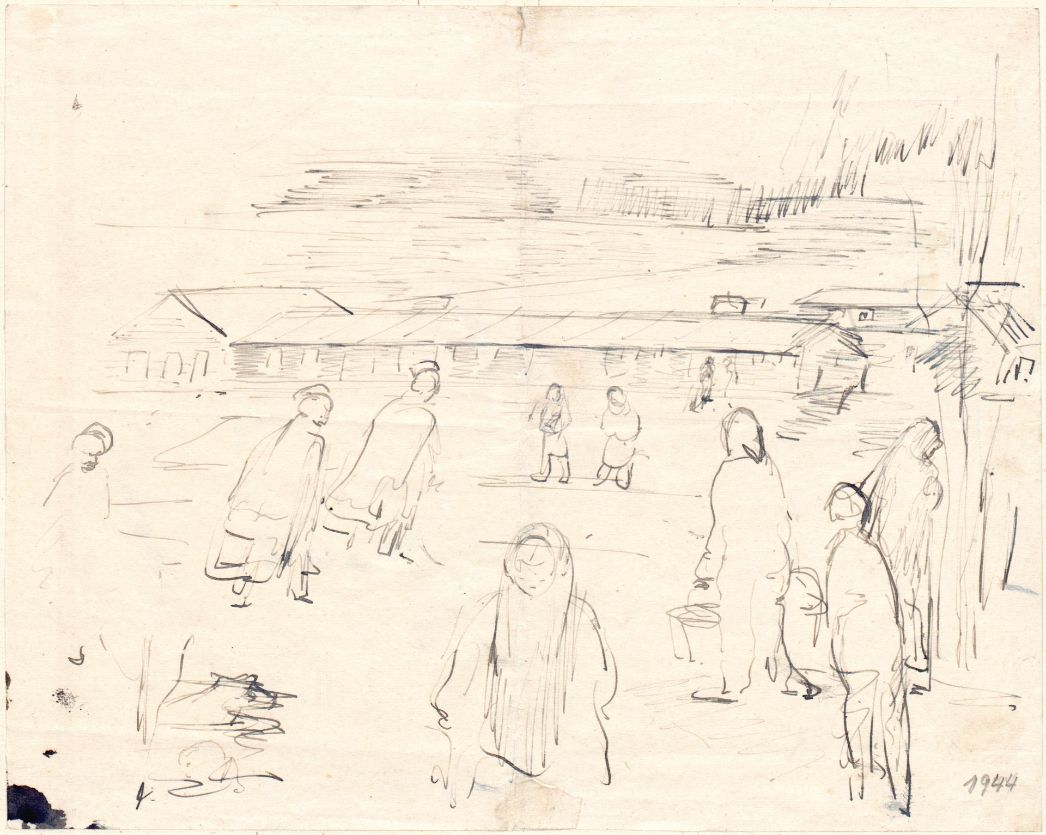
Ilse Häfner-Mode sketched her inhumane surroundings with rapid, expansive, and at the same time confident strokes: in 1944 the Gestapo had deported her to the Jewish women’s camp in the Hessian village of Elben (meanwhile a district of Naumburg) to perform forced labour. The drawing depicts women evidently transporting construction materials, possibly sand in buckets.
In the camp, Jewish women were assigned to labour detachments and forced to carry out heavy labour building their barracks and converting a tunnel to serve as a factory. Initially they had to lodge in a Wehrmacht tent set up in a former brickyard, then in an unoccupied restaurant, and from December 1944 onwards in a barrack camp. The camp consisted of four dormitory buildings and a lavatory barrack they had had to build themselves in the brickyard claypit.
The camp in the Elben claypit had been established against the background of Allied air raids. Parts of the Henschel aircraft engine works in Baunatal were to be relocated there. The operations were overseen by the “Organisation Todt” (an institution created in 1938 by Fritz Todt, the “General Plenipotentiary for the Regulation of the Construction Industry” and later “Reich Minister of Armaments and Munitions”). In this ink and steel pen drawing, Häfner-Mode documented the everyday life of forced labourers, possibly depicting herself in the figure at the centre.
Biography
The painter Ilse Häfner-Mode was born in Kempen (Poznań district) on 24 December 1902, the daughter of a Jewish pharmacists’ family. Two years later, the family moved to Berlin. In the 1920s she studied with the graphic artist Erich Wolfsfeld at the Berlin Vereinigte Staatsschule für Freie und Angewandte Kunst (United State School of Free and Applied Art). It was in this environment that she met Herbert Häfner, whom she would marry in 1927; their son Thomas was born a year later.
Ilse Häfner-Mode produced portraits and richly figural compositions in oil, watercolour, and needle painting. In 1928, the renowned art critic Paul Westheim commented on her depiction of a mother and child in the magazine Das Kunstblatt: “… this comes from Modersohn, compositionally, also in terms of ethos, also in the phraselessness of social empathy.”
After the National Socialist accession to power, her son emigrated to Ceylon in 1938 with the aid of a gallery in Basel (Switzerland) that had exhibited works by Häfner-Mode in 1931. She herself did not manage to flee Germany. On account of her Jewish descent she was prohibited from painting and exhibiting her work. The Verein Berliner Künstlerinnen (Association of Women Artists of Berlin) excluded her from its ranks. In 1942 she found refuge in rural Leopoldshöhe near Detmold (Lippe). On 19 September 1944, she was arrested by the Minden Gestapo and deported to the Elben Jewish women’s camp near Kassel. There she succeeded in drawing secretly. Later she wrote: “I always drew—no matter what.” In April 1945 she was liberated from the camp by American troops.
After the liberation, she wrote: “Dear God, please let me live a little longer on Earth, from which I can get so much good.” She stayed with friends in Switzerland, where she was able to recuperate, and then returned to Germany. She initially lived in Leopoldshöhe again. In 1955 she moved to Düsseldorf, worked as an artist, and exhibited on multiple occasions, for example at the Stadtgeschichtliches Museum (Museum of City History; 1969) and the Kunsthalle (1972). Ilse Häfner-Mode died in Düsseldorf in 1973.


